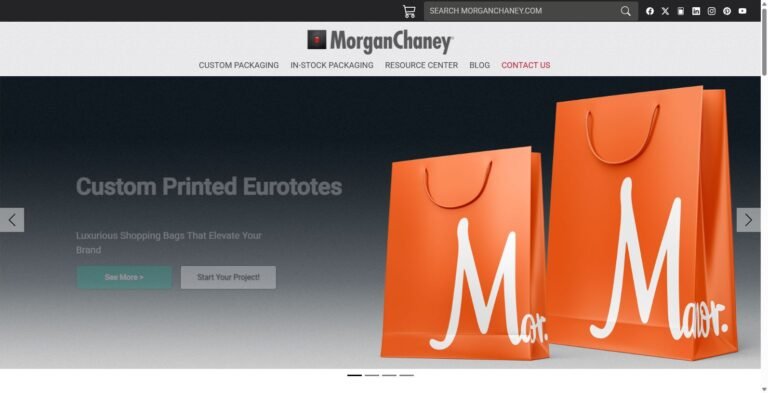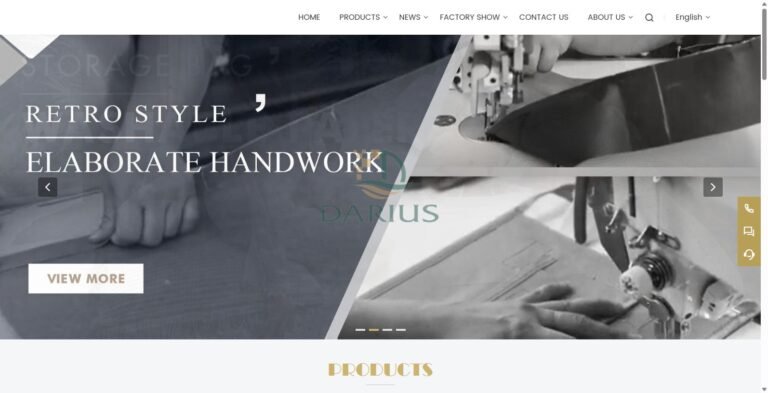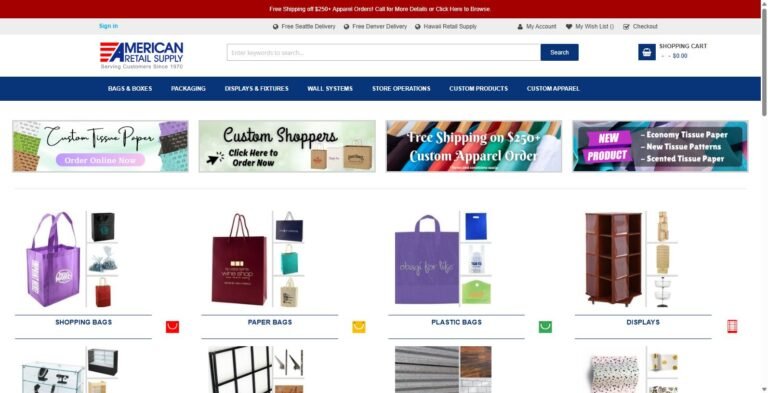A Collector’s Guide to Vintage Chinese Jewelry Boxes: More Than Just a Box
Introduction: The Enduring Allure of a Miniature Treasure
Run your hand across the surface. The finish might be gloss, and smooth lacquer, or a rough-hewn landscape of carvings in dense, fragrant wood. Jade might be cool and surprising beside brass that’s too polished, rubbing against your skin in all the wrong ways. These are the few moments where a vintage Chinese jewelry box is something you can clearly feel.
These objects are far more than simple containers. They are small works of art, each one holding history, culture, and personal stories. A vintage chinese jewelry box is a piece of decorative art that captures centuries of tradition in something you can hold in your hands.
They show amazing craftsmanship and deep meaning. We invite you to look beyond what these boxes do and discover what makes them special treasures.
The Hallmarks of Authenticity: What Defines a Vintage Chinese Jewelry Box?
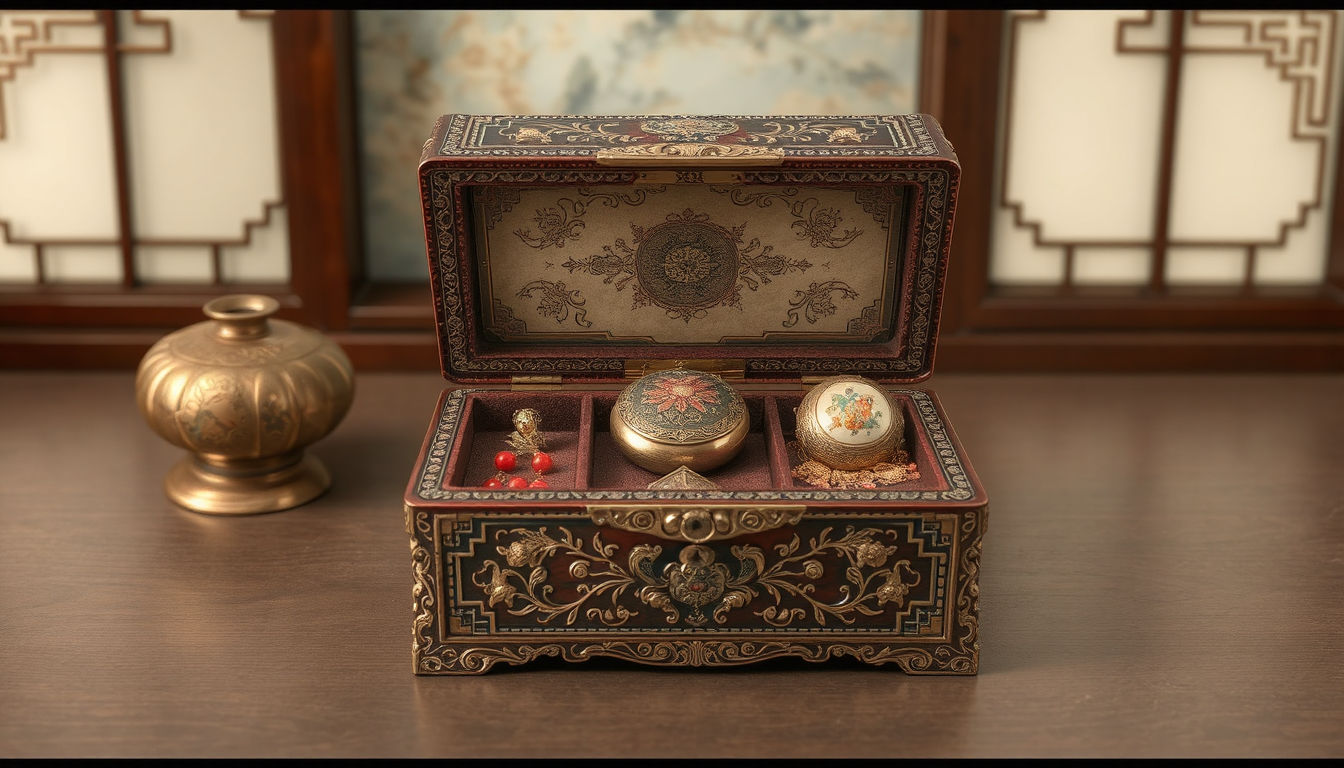
In collecting, every word counts. Just like a “vintage” is about almost the last century, while “antique” means over a century old, there is a distinction in Chinese jewelry boxes terminology. Many of the beautiful ones that you might easily find today were made in the Republic era or the modern Mass-Produced Boxes genre.
Distinguishing Vintage from Antique and Modern
In collecting, words have specific meanings. “Antique” usually means objects over 100 years old. “Vintage” describes items between 20 and 100 years old.
This difference matters for Chinese jewelry boxes. Many beautiful boxes that are easy to find today come from the Republic Era (1912-1949) and the Mid-20th Century (1950s-1970s). These are vintage items.
Modern boxes often copy old designs but are usually mass-produced. They often lack the small imperfections and quality materials that show they were made by skilled craftspeople.
Key Characteristics of Craftsmanship
A true vintage piece is authentic in the way that it was made. When you’re inspecting a box, be sure to look for these signs of realness:
-
Handmade Traces:Seek the slight unevenness, differing tool marks and hands, not machines, in the joins.
-
Material Integrity: Seasoned woods develop a richness of color over time. There may be fine cracks in the lacquer, and the silk linings will show gentle aging rather than perfect slickness.
-
Hardware Style: The brass or bronze parts—hinges, clasps, and corner guards—tend to come with designs typical of their era, and they generally aren’t particularly shiny or polished.
A Journey Through Materials and Styles: From Lacquer to Rosewood
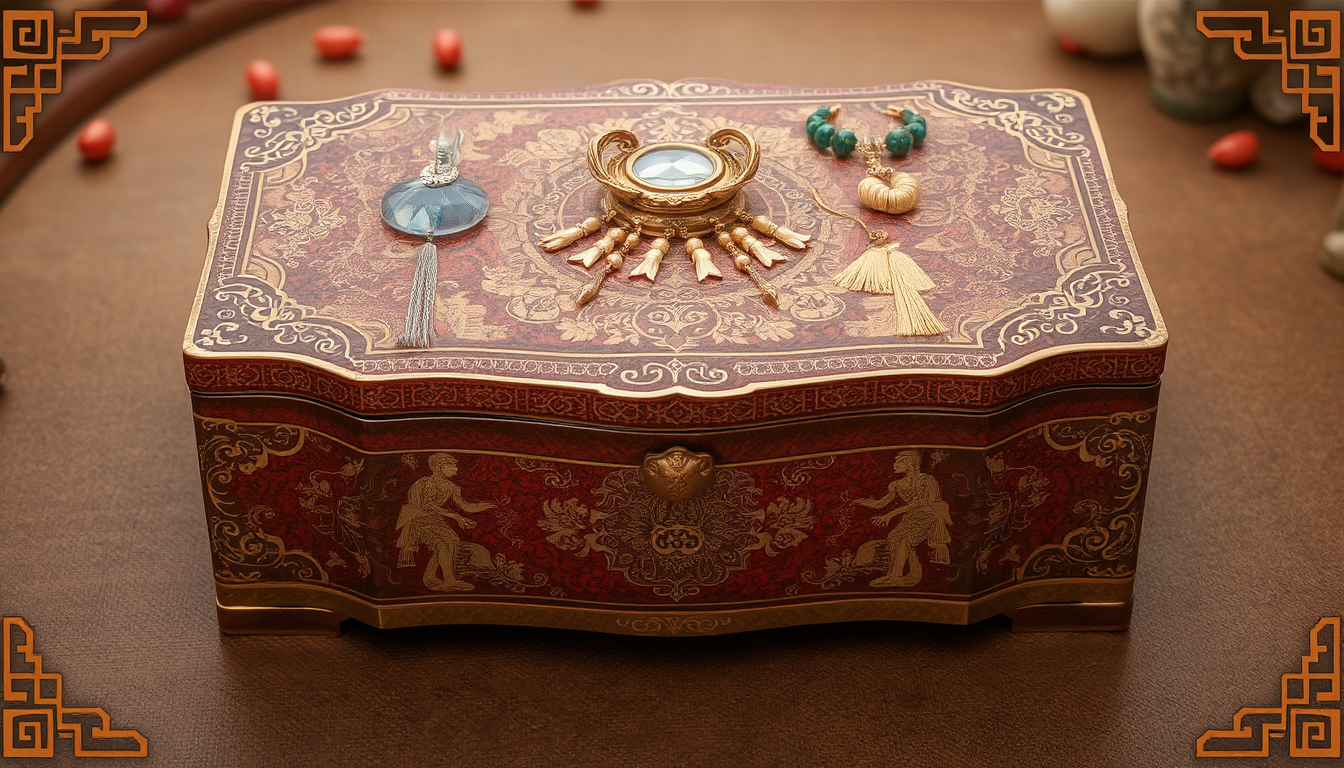
The history of a vintage Chinese jewelry box is very close to the material it’s made out of. Each material required different skills and had its own cultural significance, leading to many different styles.
The Lustrous World of Lacquerware (漆器)
Lacquer comes from the sap of the lacquer tree. Making it requires many layers, sometimes hundreds, each needing to dry in warm, humid conditions. This is a craft perfected over millennia, creating a surface that lasts and looks beautiful.
Vintage lacquer boxes tend to be deep red (from cinnabar) or shiny black. Decorations were applied by use of gilding or inlaid work.
The Enduring Elegance of Carved Wood (木雕)
Wood is central to Chinese furniture and the decorative arts. Antique jewelry boxes would also be constructed from certain precious woods, primarily selected for their density, grain and color.
Rosewood (花梨木/酸枝木) is perhaps the most common, known for its rich, reddish-brown colors and beautiful grain that darkens with age. Rarer boxes might be made from Zitan (紫檀), an almost black, very dense wood that the imperial court valued highly. Camphor (樟木) was also popular, especially for linings, because of its nice smell and ability to repel insects. These boxes are beautiful because of their precise carvings.
The Precious Touch of Inlay Art (镶嵌艺术)
It’s the inlaid work that makes a jewelry box special. This is an inlay process where well formed pieces of one material are seated within the surface of another.
Mother-of-Pearl (螺钿) inlay is widely spun to create pictures of court life, birds, flowers. The shell does capture light so adds a lively feel to the box.
Carved Jade (玉雕) inlay has great cultural meaning. Jade is the “stone of heaven,” standing for purity, health, and good fortune. Small, expertly carved jade pieces—often showing plants or lucky symbols—were set into box lids, creating a strong focal point.
Other Notable Styles
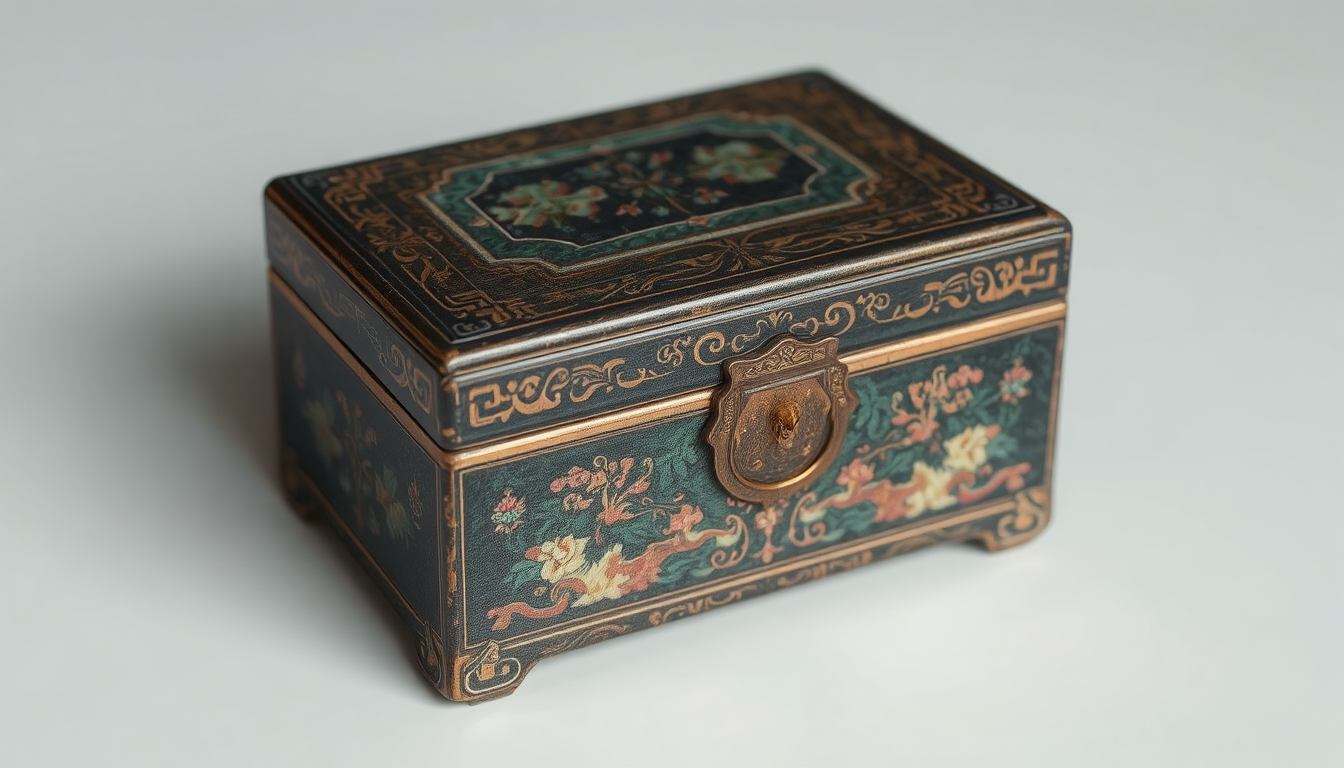
Two other styles deserve mention. Cinnabar (剔红) boxes are carved lacquerware where layers of red lacquer are built up thick and then carved to reveal detailed, raised scenes.
Cloisonné (景泰蓝) boxes are metalworking techniques applied to metalwork decorated with colored inlays, Be the surface decoration made of colored glass paste,or-cut gemstones. These are then filled with coloured enamel paste and fired, for a brilliant jewel-like result.
| Material/Style | Key Characteristics | Common Motifs | Era/Origin Notes |
| Lacquerware | Smooth, glossy finish; often red or black; lightweight. | Landscapes, figures, dragons. | Craft dates back thousands of years. |
| Rosewood | Rich, dark reddish-brown wood; dense and heavy; intricate carvings. | Longevity symbols, floral patterns. | Popular in Qing Dynasty and later. |
| Mother-of-Pearl Inlay | Iridescent shell pieces set into lacquer or wood. | Birds, flowers, court scenes. | A detailed and delicate art form. |
| Jade Inlay | Carved jade pieces (often white or green) set into the lid/front. | “Good fortune” symbols, bats, flowers. | Jade is highly prized in Chinese culture. |
Decoding the Hidden Language: Symbolism in Chinese Jewelry Boxes
To really appreciate a vintage Chinese jewelry box, you must learn to read its visual language. The designs are rarely just for show; they are part of a rich tapestry of symbolism in Chinese art, each carrying wishes for luck, long life, and happiness.
Mythical Creatures of Power and Fortune
-
Dragon (龙): The embodiment of power, strength and good luck. The dragon is synonymous for the Emperor and the male yang energy.
-
Phoenix (凤): Queen of birds: beauty, good luck and prosperity. It is the sign for the Empress and the feminine yin power. Side-by-side dragon and phoenix are emblem for happy marriage.
Flora and Fauna with Auspicious Meanings
-
Peony (牡丹): The “king of the flowers” is an emblem for prosperity, and honor and commanding power.
-
Lotus (莲花): Having a clean bloom coming up from murky water makes the lotus a strong representation of purity, enlightenment, and integrity.
-
Bat (蝙蝠): The name of the bat, fú, is homophonous with the Chinese word for good fortune (福). A bat directly represents luck. Five is the number of bats grouped around the center.
-
Crane (鹤) & Pine Tree (松): They are both strong symbols of a long life. The crane was believed to live for a thousand years, and the evergreen pine survives the winter, so together they made a popular pair for someone to hope to live a long and respected life.
Symbols of LongevitySymbols of Longevity and Happiness
-
Shou Symbol (寿): A Chinese character, stylized and direct in its meaning: Long Life. It appears in various ornamental usages.
-
Double Happiness Symbol (囍): Two Chinese characters together, representing “joyful,” are often found on decorations for a wedding. But to find it on a jewelry box, as I did, it tells me that maybe it was gifted as congratulations and best wishes gift to a new couple.
A Practical Guide for Collectors: How to Identify, Value, and Purchase
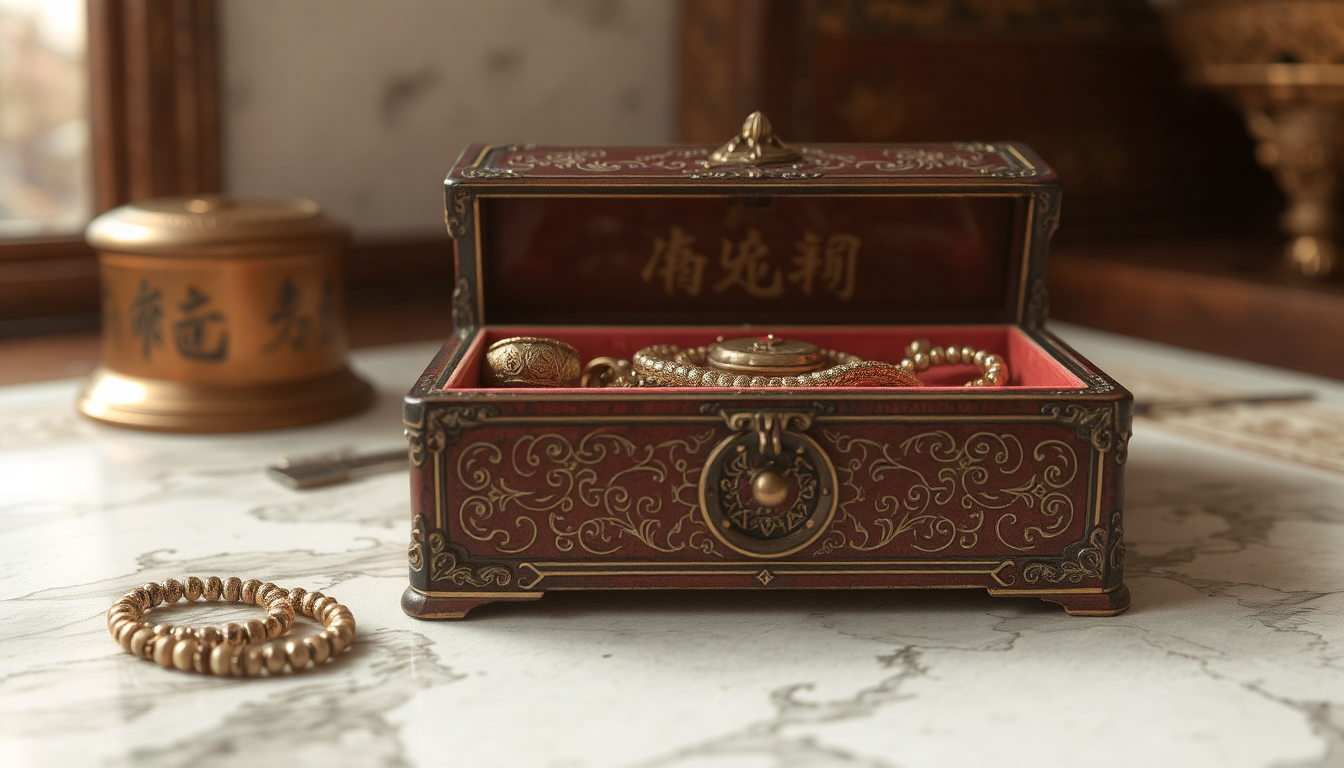
With knowledge of styles and symbols, we can now look at the practical aspects of collecting. Evaluating a piece requires a careful eye and systematic approach. We use this checklist to start.
Step-by-Step Identification Checklist
-
Examine the Construction: Look at the corners and joints. Are they fitted with handmade dovetails or other traditional joinery? Modern pieces often just use glue and nails, which show mass production.
-
Assess the Patina and Wear: Real age reveals itself in the light hand wear-its patterns are logical and discreet. Feel for softness on the corners and edges that are handled most. The patina — the lovely sheen that time bestows on wood and metal — should be uniform. You can read more here about identifying artificially aged specimens, which typically have a scuzzier and more uneven appearance.
-
Inspect the Hardware: Original brass hardware will show natural aging. The clasps, hinges, and handles should feel solid. Many vintage pieces have distinctive “cloud” shaped hasps or simple, elegant pulls that look different from modern, machine-made hardware.
-
Look Inside: The interior tells a story. Is the lining original? Vintage boxes were often lined with silk or brocade, which will show age through fading or slight fraying, especially at the edges. It may also have a faint, pleasant smell of old wood or silk, not the chemical smell of modern glues.
Factors That Influence Value
Not all vintage boxes are equal. Desirability and market value of a piece is influenced by a number of factors:
-
Craftsmanship & Complexity: The more intricate the carving, the more careful the lacquer painting, or the finer the inlay, the higher the quality, and the value. One which is deep Cinnabar carving with layering in the design is more valuable than a plain one.
-
Materials: Most expensive are boxes made of rare woods such as Zitan or Huanghuali. Equally, large, fine and exceptionally carved pieces of jade inlay are of very high value.
-
Condition: Wholeness is very important. Minor wear should also be expected and is a part of the item’s charm. But if it has major cracks, missing inlay, broken hardware, or the worst; spent 40. Also, severe water damage (important) brings value down a lot.
-
Provenance:And just like real estate, it’s difficult to track a provenance, but a box with a known history — who owned it, where it came from — is always more valuable.
Tips for Smart Purchasing
-
Ask for detailed photos. A good seller (you should always deal with a reputable dealer) will gladly send images (via email) of the bottom, the inside, the joints, and close-ups of any hardware or carvings.
-
Don’t be afraid to ask questions. Ask about the seller’s understanding of the item’s history, the piece having undergone any restorations, and the overall condition. You can learn a lot from their answers.
-
Compare prices for similar items to understand the market, but remember that because these are handmade, no two are exactly alike. Value a piece based on its own qualities—its craftsmanship, condition, and the story it tells you.
Caring for Your Timeless Treasure
If you’ve purchased a vintage Chinese jewelry box, you’ll want to take good care of it so future generations can appreciate its beauty and value. The solution lies in gentle, simplified care.
Cleaning and Maintenance
-
Wood:Clean the wood with a dry, soft, microfiber cloth to remove dust. Stay away from any chemical polishes and sprays as they can ruin the original finish and patina.
-
Lacquer: Care for lacquerware as you would fine wood. Dust with a dry, soft cloth. Store in a spot that isn’t exposed to direct sunlight, as sunlight can cause it to fade, and steer clear of spots that experience big changes in temperature or humidity, as they can cause it to crack.
-
Brass:Can I keep the patina on my hardware? This layer of soft, dark oxidation is aging and desired by collectors. It can ruin the value of the antique if you polish it away.
Storage and Display
-
Keep your box stored in a secure and dry place that is not behind a radiator or against a damp wall.
-
Like it strong, but don’t place heavy items on the box as it will stress the lid and hinges.
Conclusion: A Legacy in Your Hands
A vintage Chinese jewelry box is a doorway to the past. It connects you to an artisan who spent many hours carving, lacquering, and inlaying. It carries cultural wishes for happiness and long life, shown through a silent language of symbols.
When you hold one, you are not just holding a box. You are holding a piece of history, a work of art, and a legacy of craftsmanship. It is a personal object meant to be used, loved, and passed down.
It’s not just an object; it’s a story waiting to be told.
FAQ
-
What makes a Chinese jewelry box “vintage” instead of antique?
The vintage Chinese jewelry boxes range from 20 to 100 years old (from the 1920’s to early 2000’s) and antiques are of course over 100 years old. The majority of collectible items are from the Republic Era (1912-1949), and Mid-20th-century. -
How can I tell if a vintage Chinese jewelry box is authentic?
Seek out handmade signs such as subtle irregularities, tool marks, traditional joinery, a natural patina on wood and the right hardware for the age. The real ones have Wi-Fi patterns and silk linings with some aging. -
What are the most valuable materials used in vintage Chinese jewelry boxes?
In terms of the materials used rare woods such as Zitan and Huanghuali fetch the highest prices, as do pieces featuring a lot of jade inlay, finely polished mother of pearl or intricate carving in cinnabar lacquer. Craftsmanship quality greatly affects value. -
What symbols should I look for on vintage Chinese jewelry boxes?
Popular auspicious symbols are dragons (power), phoenixes (beauty), bats (good fortune), peonies (wealth), lotus flowers (purity) and the “shou” character (longevity). These fripperies were thus given significant wishes. -
How should I care for my vintage Chinese jewelry box in 2025?
Lightly dust with a soft, dry microfiber cloth. Do not use chemical cleaners or exposure your piece to the sun. You don’t want to strip the patina off brass hardware. Keep in a cool and dry place.


